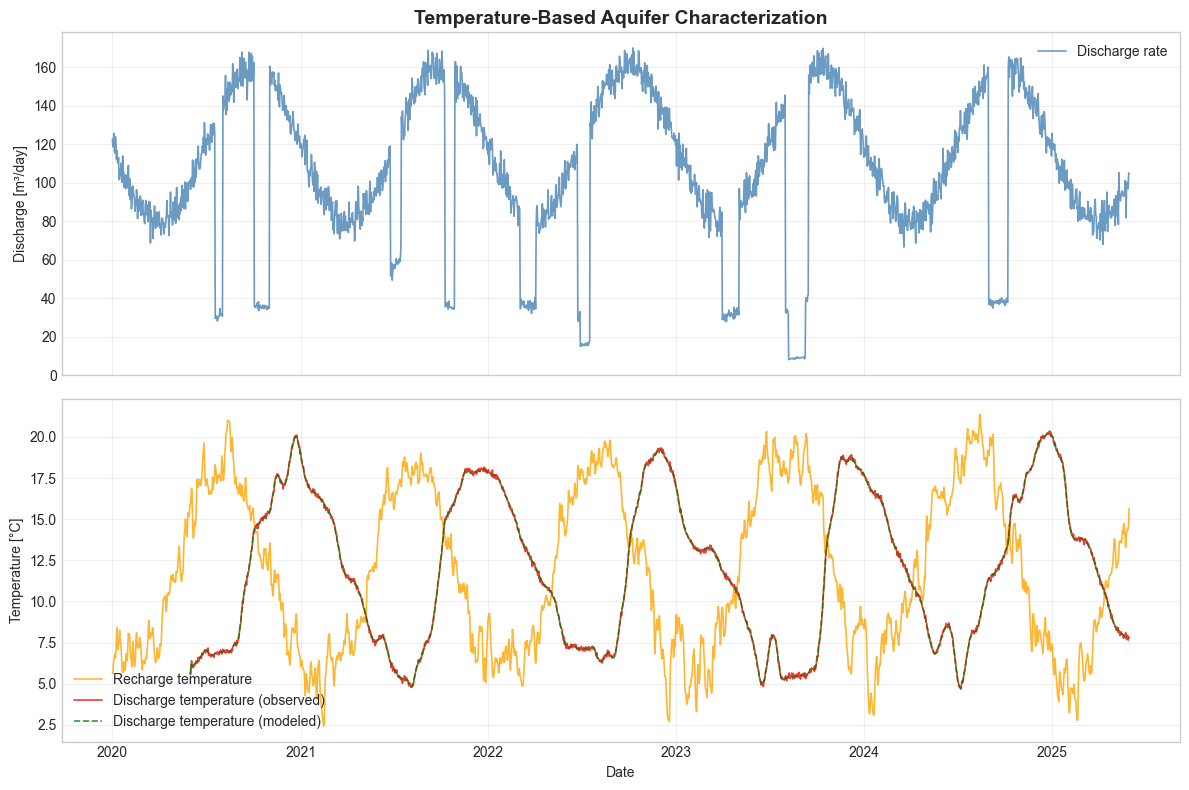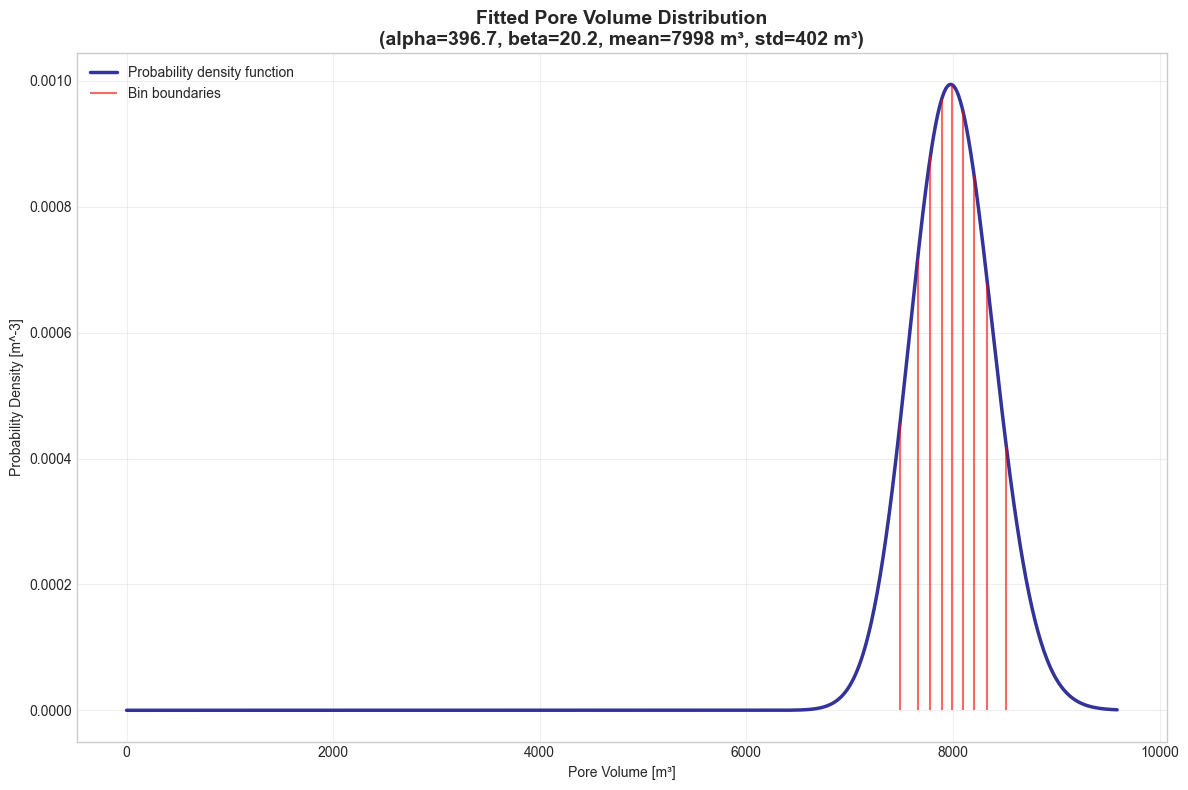Note
This notebook is located in the ./examples directory of the gwtransport repository.
Aquifer Characterization Using Temperature Response#
Learning Objectives#
Understand how temperature can be used as a natural tracer for aquifer characterization
Learn inverse modeling techniques for estimating aquifer properties
Apply gamma distribution models to represent aquifer heterogeneity
Interpret thermal breakthrough curves in hydrogeological contexts
Overview#
This notebook demonstrates inverse modeling to estimate aquifer pore volume distribution from temperature breakthrough curves. Temperature acts as a conservative tracer with known thermal retardation, allowing characterization of flow paths and residence times.
Applications#
Groundwater vulnerability assessment
Residence time distribution analysis
Contaminant transport forecasting
Aquifer heterogeneity characterization
Key Assumptions#
Stationary pore volume distribution
Advection-dominated transport (Péclet number >> 1)
Thermal retardation factor = 2.0 (typical for saturated media)
Conservative tracer behavior for temperature
Theoretical Background#
Thermal Transport in Groundwater#
Heat transport in groundwater systems is governed by:
Advection: Heat carried by flowing water
Thermal retardation: Heat exchange with solid matrix slows thermal front
Dispersion: Mechanical and thermal dispersion (often negligible for large-scale transport)
Mathematical Model#
The residence time distribution for thermal transport is related to the aquifer pore volume distribution through:
Where:
\(V_{pore}\): Pore volume [m³]
\(R_f\): Thermal retardation factor [-]
\(Q\): Flow rate [m³/day]
Gamma Distribution Model#
Aquifer heterogeneity is represented using a gamma distribution for pore volumes, characterized by shape (α) and scale (β) parameters.
[1]:
from pathlib import Path
import matplotlib.pyplot as plt
import numpy as np
from scipy.optimize import curve_fit
from scipy.stats import gamma as gamma_dist
from gwtransport import advection
from gwtransport import gamma as gamma_utils
from gwtransport.examples import generate_example_data
# Set random seed for reproducibility
np.random.seed(42)
plt.style.use("seaborn-v0_8-whitegrid")
print("Libraries imported successfully")
Libraries imported successfully
1. Synthetic Data Generation#
We generate realistic temperature and flow time series to demonstrate the inverse modeling approach. The synthetic data includes seasonal patterns and realistic variability.
[2]:
# Generate 6 years of daily data with seasonal patterns
df, tedges = generate_example_data(
date_start="2020-01-01",
date_end="2025-05-31",
flow_mean=120.0, # Base flow rate [m³/day]
flow_amplitude=40.0, # Seasonal flow variation [m³/day]
flow_noise=5.0, # Random daily fluctuations [m³/day]
temp_infiltration_method="soil_temperature", # Use real soil temperature data
aquifer_pore_volume_gamma_mean=8000.0, # True mean pore volume [m³]
aquifer_pore_volume_gamma_std=400.0, # True standard deviation [m³]
retardation_factor=2.0, # Thermal retardation factor [-]
temp_measurement_noise=0.1, # Measurement noise for temperatures. Set to zero for perfect fit.[°C]
)
print("Dataset Summary:")
print(f"Period: {df.index[0].date()} to {df.index[-1].date()}")
print(f"Mean flow: {df['flow'].mean():.1f} m³/day")
print(f"Mean infiltration temperature: {df['temp_infiltration'].mean():.1f} °C")
print(f"Mean extraction temperature: {df['temp_extraction'].mean():.1f} °C")
print(f"True mean pore volume: {df.attrs['aquifer_pore_volume_gamma_mean']:.1f} m³")
print(f"True std deviation: {df.attrs['aquifer_pore_volume_gamma_std']:.1f} m³")
Dataset Summary:
Period: 2020-01-01 to 2025-05-31
Mean flow: 105.2 m³/day
Mean infiltration temperature: 11.8 °C
Mean extraction temperature: 12.0 °C
True mean pore volume: 8000.0 m³
True std deviation: 400.0 m³
2. Parameter Estimation via Optimization#
We implement inverse modeling to estimate gamma distribution parameters using nonlinear least squares optimization. A spin-up period is excluded to allow thermal breakthrough to stabilize. Use gwtransport.residence_time.fraction_explained to compute the exact duration of the spin up period.
[3]:
# Define training dataset (exclude first year for thermal equilibration)
train_data = df["2021-01-01":].temp_extraction
train_data = train_data.dropna()
train_length = len(train_data)
print(f"Training dataset: {train_length} days")
print(f"Training period: {train_data.index[0].date()} to {train_data.index[-1].date()}")
Training dataset: 1612 days
Training period: 2021-01-01 to 2025-05-31
[4]:
def objective(_xdata, mean, std):
"""Infiltration to extraction model for temperature breakthrough with gamma-distributed pore volumes."""
print(f"Optimizing: mean={mean:.1f} m³, std={std:.1f} m³")
cout = advection.gamma_infiltration_to_extraction(
cin=df.temp_infiltration,
flow=df.flow,
tedges=tedges,
cout_tedges=tedges,
mean=mean, # Mean pore volume [m³]
std=std, # Standard deviation [m³]
n_bins=25, # Discretization resolution
retardation_factor=2.0, # Thermal retardation factor
)
# Return training period data
return cout[df.index >= "2021-01-01"]
[5]:
# Nonlinear least squares optimization
print("Starting parameter optimization...")
(mean, std), pcov = curve_fit(
objective,
df.index,
train_data.values,
p0=(7500.0, 450.0), # Initial parameter estimates [m³]
bounds=([5000, 200], [10000, 600]), # Physical constraints [m³]
method="trf", # Trust Region Reflective algorithm
max_nfev=250, # Limit function evaluations
)
print("\nOptimization completed!")
Starting parameter optimization...
Optimizing: mean=7500.0 m³, std=450.0 m³
Optimizing: mean=7500.0 m³, std=450.0 m³
Optimizing: mean=7500.0 m³, std=450.0 m³
Optimizing: mean=7696.9 m³, std=457.8 m³
Optimizing: mean=7696.9 m³, std=457.8 m³
Optimizing: mean=7696.9 m³, std=457.8 m³
Optimizing: mean=7838.0 m³, std=471.2 m³
Optimizing: mean=7838.0 m³, std=471.2 m³
Optimizing: mean=7838.0 m³, std=471.2 m³
Optimizing: mean=7920.4 m³, std=458.4 m³
Optimizing: mean=7920.4 m³, std=458.4 m³
Optimizing: mean=7920.4 m³, std=458.4 m³
Optimizing: mean=7958.3 m³, std=447.9 m³
Optimizing: mean=7958.3 m³, std=447.9 m³
Optimizing: mean=7958.3 m³, std=447.9 m³
Optimizing: mean=7982.0 m³, std=437.4 m³
Optimizing: mean=7982.0 m³, std=437.4 m³
Optimizing: mean=7982.0 m³, std=437.4 m³
Optimizing: mean=7989.9 m³, std=429.3 m³
Optimizing: mean=7989.9 m³, std=429.3 m³
Optimizing: mean=7989.9 m³, std=429.3 m³
Optimizing: mean=7994.0 m³, std=421.8 m³
Optimizing: mean=7994.0 m³, std=421.8 m³
Optimizing: mean=7994.0 m³, std=421.8 m³
Optimizing: mean=7996.7 m³, std=416.9 m³
Optimizing: mean=7996.7 m³, std=416.9 m³
Optimizing: mean=7996.7 m³, std=416.9 m³
Optimizing: mean=7998.2 m³, std=413.1 m³
Optimizing: mean=7998.2 m³, std=413.1 m³
Optimizing: mean=7998.2 m³, std=413.1 m³
Optimizing: mean=7999.4 m³, std=410.1 m³
Optimizing: mean=7999.4 m³, std=410.1 m³
Optimizing: mean=7999.4 m³, std=410.1 m³
Optimizing: mean=8000.5 m³, std=407.4 m³
Optimizing: mean=8000.5 m³, std=407.4 m³
Optimizing: mean=8000.5 m³, std=407.4 m³
Optimizing: mean=7999.9 m³, std=406.6 m³
Optimizing: mean=7999.9 m³, std=406.6 m³
Optimizing: mean=7999.9 m³, std=406.6 m³
Optimizing: mean=7999.1 m³, std=405.3 m³
Optimizing: mean=7999.1 m³, std=405.3 m³
Optimizing: mean=7999.1 m³, std=405.3 m³
Optimizing: mean=7998.3 m³, std=403.3 m³
Optimizing: mean=7998.3 m³, std=403.3 m³
Optimizing: mean=7998.3 m³, std=403.3 m³
Optimizing: mean=7997.4 m³, std=401.2 m³
Optimizing: mean=7997.4 m³, std=401.2 m³
Optimizing: mean=7997.4 m³, std=401.2 m³
Optimizing: mean=7997.7 m³, std=401.6 m³
Optimizing: mean=7997.7 m³, std=401.6 m³
Optimizing: mean=7997.7 m³, std=401.6 m³
Optimizing: mean=7997.6 m³, std=401.5 m³
Optimizing: mean=7997.7 m³, std=401.6 m³
Optimizing: mean=7997.7 m³, std=401.6 m³
Optimizing: mean=7997.7 m³, std=401.6 m³
Optimizing: mean=7997.6 m³, std=401.6 m³
Optimizing: mean=7997.7 m³, std=401.6 m³
Optimizing: mean=7997.7 m³, std=401.6 m³
Optimizing: mean=7997.7 m³, std=401.6 m³
Optimizing: mean=7997.7 m³, std=401.6 m³
Optimizing: mean=7997.7 m³, std=401.6 m³
Optimizing: mean=7997.7 m³, std=401.6 m³
Optimizing: mean=7997.7 m³, std=401.6 m³
Optimizing: mean=7997.7 m³, std=401.6 m³
Optimizing: mean=7997.7 m³, std=401.6 m³
Optimizing: mean=7997.7 m³, std=401.6 m³
Optimizing: mean=7997.7 m³, std=401.6 m³
Optimizing: mean=7997.7 m³, std=401.6 m³
Optimizing: mean=7997.7 m³, std=401.6 m³
Optimizing: mean=7997.7 m³, std=401.6 m³
Optimizing: mean=7997.7 m³, std=401.6 m³
Optimizing: mean=7997.7 m³, std=401.6 m³
Optimizing: mean=7997.7 m³, std=401.6 m³
Optimizing: mean=7997.7 m³, std=401.6 m³
Optimizing: mean=7997.7 m³, std=401.6 m³
Optimizing: mean=7997.7 m³, std=401.6 m³
Optimizing: mean=7997.7 m³, std=401.6 m³
Optimizing: mean=7997.7 m³, std=401.6 m³
Optimizing: mean=7997.7 m³, std=401.6 m³
Optimization completed!
[6]:
# Generate model predictions using optimized parameters
df["temp_extraction_modeled"] = advection.gamma_infiltration_to_extraction(
cin=df.temp_infiltration,
flow=df.flow,
tedges=tedges,
cout_tedges=tedges,
mean=mean, # Fitted mean pore volume
std=std, # Fitted standard deviation
n_bins=250, # High computational resolution
retardation_factor=2.0, # Thermal retardation
)
# Report optimization results with uncertainty estimates
print("Parameter Estimation Results:")
print(f"Mean pore volume: {mean:.1f} ± {pcov[0, 0] ** 0.5:.1f} m³")
print(f"Standard deviation: {std:.1f} ± {pcov[1, 1] ** 0.5:.1f} m³")
print(f"Coefficient of variation: {std / mean:.2f}")
# Compare with true values
true_mean = df.attrs["aquifer_pore_volume_gamma_mean"]
true_std = df.attrs["aquifer_pore_volume_gamma_std"]
print(f"\nTrue values: {true_mean:.1f} m³ (mean), {true_std:.1f} m³ (std)")
print(
f"Relative error: {abs(mean - true_mean) / true_mean * 100:.1f}% (mean), {abs(std - true_std) / true_std * 100:.1f}% (std)"
)
Parameter Estimation Results:
Mean pore volume: 7997.7 ± 0.9 m³
Standard deviation: 401.6 ± 1.1 m³
Coefficient of variation: 0.05
True values: 8000.0 m³ (mean), 400.0 m³ (std)
Relative error: 0.0% (mean), 0.4% (std)
3. Model Validation and Visualization#
We compare observed and modeled temperature breakthrough curves to assess model performance.
[7]:
fig, (ax1, ax2) = plt.subplots(figsize=(12, 8), nrows=2, ncols=1, sharex=True)
# Flow rate subplot
ax1.set_title("Temperature-Based Aquifer Characterization", fontsize=14, fontweight="bold")
ax1.plot(df.index, df.flow, label="Discharge rate", color="steelblue", alpha=0.8, linewidth=1.2)
ax1.set_ylabel("Discharge [m³/day]")
ax1.legend()
ax1.grid(True, alpha=0.3)
# Temperature subplot
ax2.plot(df.index, df.temp_infiltration, label="Recharge temperature", color="orange", alpha=0.8, linewidth=1.2)
ax2.plot(df.index, df.temp_extraction, label="Discharge temperature (observed)", color="red", alpha=0.8, linewidth=1.2)
ax2.plot(
df.index,
df.temp_extraction_modeled,
label="Discharge temperature (modeled)",
color="green",
alpha=0.8,
linewidth=1.2,
linestyle="--",
)
ax2.set_xlabel("Date")
ax2.set_ylabel("Temperature [°C]")
ax2.legend()
ax2.grid(True, alpha=0.3)
plt.tight_layout()
# Save the temperature response plot
out_path = Path("01_Temperature_response.png")
plt.savefig(out_path, dpi=300, bbox_inches="tight")
plt.show()
print(f"Temperature response plot saved to: {out_path}")

Temperature response plot saved to: 01_Temperature_response.png
4. Pore Volume Distribution Analysis#
We visualize the fitted gamma distribution representing spatial heterogeneity in pore volume. Each bin represents a different flow path through the aquifer.
[8]:
# Discretize gamma distribution into flow path bins
n_bins = 10 # Reduced for visualization clarity
alpha, beta = gamma_utils.mean_std_to_alpha_beta(mean, std)
gbins = gamma_utils.bins(alpha=alpha, beta=beta, n_bins=n_bins)
print(f"Gamma Distribution Parameters: alpha={alpha:.1f}, beta={beta:.1f}")
print(f"Discretized into {n_bins} equiprobable bins:")
print("-" * 80)
print(f"{'Bin':3s} {'Lower [m³]':10s} {'Upper [m³]':10s} {'E[V|bin]':10s} {'P(bin)':10s}")
print("-" * 80)
for i in range(n_bins):
upper = f"{gbins['upper_bound'][i]:.1f}" if not np.isinf(gbins["upper_bound"][i]) else "∞"
lower = f"{gbins['lower_bound'][i]:.1f}"
expected = f"{gbins['expected_value'][i]:.1f}"
prob = f"{gbins['probability_mass'][i]:.3f}"
print(f"{i:3d} {lower:10s} {upper:10s} {expected:10s} {prob:10s}")
Gamma Distribution Parameters: alpha=396.7, beta=20.2
Discretized into 10 equiprobable bins:
--------------------------------------------------------------------------------
Bin Lower [m³] Upper [m³] E[V|bin] P(bin)
--------------------------------------------------------------------------------
0 0.0 7487.6 7308.2 0.100
1 7487.6 7657.9 7579.1 0.100
2 7657.9 7782.3 7722.2 0.100
3 7782.3 7889.7 7836.9 0.100
4 7889.7 7990.9 7940.5 0.100
5 7990.9 8093.1 8041.7 0.100
6 8093.1 8203.3 8147.1 0.100
7 8203.3 8333.5 8265.9 0.100
8 8333.5 8516.4 8417.7 0.100
9 8516.4 ∞ 8717.3 0.100
[9]:
# Plot the gamma distribution and bins
x = np.linspace(0, 1.1 * gbins["expected_value"][-1], 1000)
y = gamma_dist.pdf(x, alpha, scale=beta)
fig, ax = plt.subplots(figsize=(12, 8))
ax.set_title(
f"Fitted Pore Volume Distribution\n(alpha={alpha:.1f}, beta={beta:.1f}, mean={mean:.0f} m³, std={std:.0f} m³)",
fontsize=14,
fontweight="bold",
)
ax.plot(x, y, label="Probability density function", color="navy", alpha=0.8, linewidth=2.5)
pdf_at_lower_bound = gamma_dist.pdf(gbins["lower_bound"], alpha, scale=beta)
ax.vlines(
gbins["lower_bound"],
0,
pdf_at_lower_bound,
color="red",
alpha=0.6,
linewidth=1.5,
label="Bin boundaries",
)
ax.set_xlabel("Pore Volume [m³]")
ax.set_ylabel("Probability Density [m^-3]")
ax.legend()
ax.grid(True, alpha=0.3)
plt.tight_layout()
# Save the pore volume distribution plot
out_path = Path("01_Pore_volume_distribution.png")
plt.savefig(out_path, dpi=300, bbox_inches="tight")
plt.show()
print(f"Pore volume distribution plot saved to: {out_path}")

Pore volume distribution plot saved to: 01_Pore_volume_distribution.png
Results & Discussion#
Model Performance#
The inverse modeling successfully recovered the aquifer pore volume distribution parameters with good accuracy. The fitted gamma distribution captures the heterogeneity in flow paths through the aquifer.
Engineering Insights#
Thermal Retardation: The factor of 2.0 represents heat exchange between groundwater and the solid matrix
Flow Path Variability: The gamma distribution shows that some water follows fast paths while other water has much longer residence times
Seasonal Effects: Flow rate variations cause seasonal changes in residence time distributions
Practical Applications#
Contaminant Transport: Use fitted parameters to predict pollutant breakthrough
Well Field Design: Optimize extraction rates based on residence time requirements
Vulnerability Assessment: Identify fast flow paths that may compromise water quality
Key Takeaways#
✅ Temperature as Natural Tracer: Temperature provides valuable information about aquifer properties without artificial injection
✅ Inverse Modeling: Optimization techniques can extract quantitative aquifer parameters from field observations
✅ Gamma Distribution: Effective model for representing aquifer heterogeneity in engineering applications
✅ Thermal Retardation: Must account for heat exchange when using temperature data
✅ Spin-up Period: Allow sufficient time for thermal equilibration before parameter estimation